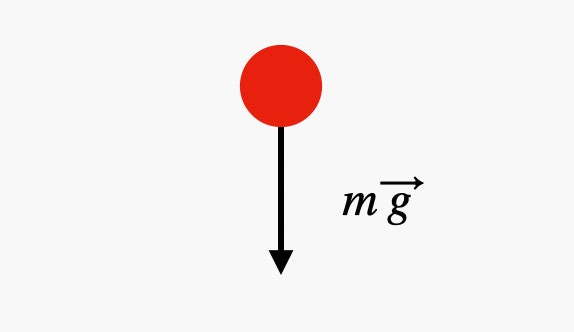If there’s one thing that you should learn from physics, it’s that big things are not like small things. I don’t just mean that big things are bigger, or even that big things are more massive. (That’s too obvious.) I mean that when big things fall, they do it in a different manner than small things.
In physics, we like to start with the simplest possible case. So let’s start with a regular falling ball, like this:
Illustration: Rhett Allain
It’s just a single ball being acted upon by a single force: the gravitational force due to the ball’s interaction with the Earth. The magnitude of this force is the product of the ball’s mass (m) and the local gravitational field (g). Newton’s second law says that the total force (we call that the net force) is equal to the product of an object’s mass and its acceleration. Since this is the only force and it also depends on the mass, the ball will fall down and accelerate with a magnitude of g (9.8 m/s2).
Now let’s make it just a little bit more complicated. I’m going to take that same ball AND add a very low-mass, 1-meter-long stick to it. One end of this stick will be attached to the ground, but able to pivot. The ball will be put on the other end so that the ball-stick combo is almost vertical. (If it is exactly vertical it will never fall over—so this one will be leaning a little bit.)
Video: Rhett Allain
If you want to see all the physics details I used to make that animation—don’t worry, I have you covered:
Content
This content can also be viewed on the site it originates from.
With the addition of the stick, things get a bit more complicated because it adds an extra force acting on the ball. Although it’s quite simple to calculate the gravitational force acting on the falling ball, the force from the stick is not so easy. When the stick interacts with the ball, it can either push it away from the pivot point on the ground, or it can pull it towards the pivot.
In fact, the value of this “stick force” (I just made up that name) depends on both the position and velocity of the ball. It’s what we call a “force of constraint.” It pushes or pulls with whatever value is needed to keep that ball the same distance from the pivot point.
Since it’s a force of constraint, there isn’t a simple equation for it, so we won’t explicitly calculate this stick force. Instead, I will model the motion of the ball using polar coordinates. This brings into play some more complicated physics—but it works out OK. (You can see the explanation in the video above.)



